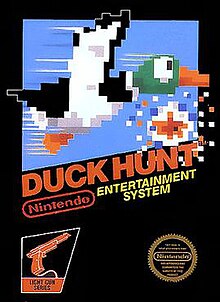
Back داك هانت Arabic داك هانت ARZ Duck Hunt AST Duck Hunt Byelorussian Duck Hunt Catalan Duck Hunt German Duck Hunt Greek Duck Hunt Spanish Duck Hunt Basque شکار اردک Persian
| Duck Hunt | |
|---|---|
 North American box art | |
| Developer(s) | Nintendo R&D1 Intelligent Systems[4][5] |
| Publisher(s) | Nintendo |
| Director(s) | Shigeru Miyamoto[6] |
| Producer(s) | Gunpei Yokoi |
| Designer(s) | Shigeru Miyamoto[6] Hiroji Kiyotake |
| Programmer(s) | Kenji Nakajima |
| Artist(s) | Hiroji Kiyotake |
| Composer(s) | Hirokazu Tanaka |
| Platform(s) | Nintendo Entertainment System, Arcade |
| Release | NES Arcade (VS. Duck Hunt) |
| Genre(s) | Light gun shooter, sports, shooting gallery |
| Mode(s) | Single-player, multiplayer |
| Arcade system | Nintendo VS. System, PlayChoice-10 |
Duck Hunt[a] is a 1984 light gun shooter video game developed and published by Nintendo for the Nintendo Entertainment System (NES) video game console and the Nintendo VS. System arcade hardware. The game was first released in April 1984, in Japan for the Family Computer (Famicom) console and in North America as an arcade game. It became a launch game for the NES in North America in October 1985, and was re-released in Europe two years later.
Players fire the NES Zapper at a CRT television,[7] with three attempts per round to shoot ducks and clay pigeons.
The game initially received a positive reception in the mid-1980s,[8] but was later given mild praise in retrospective reviews.[9][10] The game was inspired by Nintendo's previous Duck Hunt electro-mechanical arcade game which was based on the Laser Clay Shooting System released in 1976.[11] Upon release as a video game, Duck Hunt became a major commercial success both for arcades and consoles in the 1980s, helping to popularize light gun video games with over 28 million copies sold worldwide.
In 1986, the nationwide launch of the NES included the Deluxe Set bundle with pack-in games Duck Hunt and Gyromite. The later Action Set has Duck Hunt and Super Mario Bros. on one cartridge. The final Duck Hunt bundle is the Power Set, with a multi-cart with World Class Track Meet, Super Mario Bros., and Duck Hunt. The game was released on Virtual Console for the Wii U in 2014.
- ^ "retrodiary: 1 April – 28 April". Retro Gamer (88). Bournemouth: Imagine Publishing: 17. April 2011. ISSN 1742-3155. OCLC 489477015.
- ^ "PlayChoice-10: 10 Top Games In One Goliath Cabinet, Electrocoin (UK)". The Arcade Flyer Archive. Retrieved June 19, 2021.
- ^ Cite error: The named reference
Akagiwas invoked but never defined (see the help page). - ^ "Games - Intelligent Systems Co., Ltd". intsys.co.jp. Archived from the original on February 19, 2017. Retrieved August 4, 2020.
- ^ "I.S. Company Information". intsys.co.jp. Archived from the original on January 10, 1998. Retrieved August 4, 2020.
- ^ a b Yamashita, Akira (January 8, 1989). "Shigeru Miyamoto Interview: Profile of Shigeru Miyamoto". Micom BASIC (in Japanese) (1989–02).
Famicom (as director & game designer) - Hogan's Alley, Excitebike, Super Mario Bros., The Legend of Zelda, Wild Gunman, Duck Hunt, Devil World, Spartan X
- ^ Fitzpatrick, Jason (October 6, 2018). "How the Nintendo NES Zapper Worked, and Why It Doesn't Work On HDTVs". www.howtogeek.com. Retrieved January 3, 2019.
- ^ Cite error: The named reference
Adlumwas invoked but never defined (see the help page). - ^ Cite error: The named reference
Allgame reviewwas invoked but never defined (see the help page). - ^ Cite error: The named reference
Gamespot peoplewas invoked but never defined (see the help page). - ^ "Nintendo Duck Hunt (1976)". Archived from the original on March 2, 2007.
Cite error: There are <ref group=lower-alpha> tags or {{efn}} templates on this page, but the references will not show without a {{reflist|group=lower-alpha}} template or {{notelist}} template (see the help page).